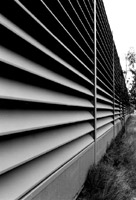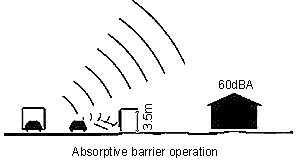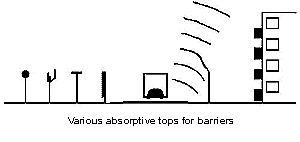Tools & Resources
Absorptive Barriers for Traffic Noise Reduction
Noise barriers along urban freeways have long been controversial, but recently concerns have been expressed about aesthetics as much as noise. New types of steel absorptive barriers offer promising solutions to both concerns.
Absorptive barriers present a very effective alternative where the height of the barriers is an issue. In addition, they offer noise abatement for residences more remote from a road. Such residences are often subject to noise transferred by temperature inversions.
Noise control legislation in all states allows environmental authorities to force road construction authorities to reduce noise to acceptable standards. In all states, except New South Wales and the Northern Territory, design criteria for new highways set a daytime design noise level goal of 63 dBA. The Northern Territory stands alone in having no specified limits. In New South Wales, the Roads & Traffic Authority (RTA) has set a design goal of 60 dBA for road traffic noise at residences near a new highway. However, the Environment Protection Authority has proposed a tougher standard of 55 dBA (the RTA's current night-time standard), and is already implementing this standard on specific land development projects. The 60 dBA is achievable with wide buffer zones and/or reasonable height barriers.
Future standards will require more effective noise reduction measures, including wider buffer zones, very high reflective barriers or medium height absorptive barriers. Vehicles themselves offer no imminent improvement, as Australian Design Rules (ADRs) for motor vehicle noise appear to be close to the current limit of technology. Engine noise is the dominant concern at low speeds, with tyre noise becoming the concern at higher speeds.
Tyre noise is exacerbated by the rough road textures desirable for vehicle grip, especially in the wet. However, it can be reduced by lower speed limits and by good tyre design, such as irregular tread patterns which reduce "singing" sounds.
Among the noise control measures available to highway designers is open-graded asphalt, which reduces noise by approximately 3 dBA. Further noise reduction must be achieved by wider buffer strips along each side of the road and/or roadside noise barriers.
Barriers v Buffers
Required buffer distances vary greatly according to the size and type of roadside noise barriers employed. Given a traffic flow of e.g. 50,000 vehicles per day at 110 km/h, the buffer width can range between 20 and 500 metres to meet the 60 dBA standard.
| Required Buffer Widths | ||
| Barrier Height | Barrier Type | |
| Reflective | Absorptive | |
| 3m 4m 5m 6m | 180m 100m 65m 35m | 90m 50m 35m 20m |
| None | 500m | |
The table showing relative buffer widths demonstrates the significance of barrier height and type. For example, a three metre high absorptive barrier will result in a 60 dBA noise level at a buffer distance of 90 metres from the source, whereas a four metre reflective barrier will achieve the same noise level at a distance of 100 metres. The table should be taken as a general guide only, as it takes no account of ground absorption, road gradient, percentage of heavy vehicles, road surface and angle of road viewed from the receptor location. However, it illustrates the fundamental trade-off between buffer distance and barrier height. It also illustrates the value of absorptive barriers as a means of balancing a narrow buffer width with a lower barrier height.
In cases where an existing road is widened and where high barriers will present aesthetic problems, the attraction of absorptive barriers is clear. In residential areas near a high-speed freeway, a five-metre high reflective noise barrier can reduce the buffer strip width from 500 metres to 65 metres. Significantly, an absorptive barrier to achieve the same effect would be less than four metres high.
The erected cost of the barrier may be greater, but that extra 435 metres of land could be worth much more per metre than the barrier. It is apparent that roadside and railside barriers are of great cost-benefit to the community, making them a good investment of public funds. Importantly, the value of the land may be further enhanced by the use of a lower absorptive barrier, favouring this technology.
Reflective barriers
A reflective barrier works by reflecting traffic noise up into the air. The higher the barrier, the more noise is reflected upwards, and the less noise is propagated laterally toward nearby residences. However, there is a limit. Maekawa, the Japanese scientist who developed the formula for barrier attenuation, showed there is a practical limit of 24 dB noise reduction at any frequency for a reflective barrier, no matter how high it is made.
For practical purposes, the noise reduction from reflective barriers is in the order of 10 to 14 dBA under neutral weather conditions. Under unfavourable weather conditions, such as a slight breeze or temperature inversion, the sound will be refracted back down towards the ground at a distance of 500 metres or more. An increase in noise level in the order of 10 dBA is not unusual for such weather conditions. This represents a doubling of loudness, and under these conditions residents may well complain about noise barriers that don't seem to work.
|
Absorptive barriers
An absorptive barrier works by absorbing some of the traffic noise energy into the porous facing and also reflecting some of the noise energy up into the air. Energy absorbed by the barrier facing reduces the build-up of sound pressure in front of and above the barrier. This increases the acoustic shadow thrown by the barrier and further reduces noise behind the barrier.
The additional noise absorption varies with the efficiency of the absorber and the height of the barrier. Variations of 1 to 10 dBA have been claimed by various tests. An efficient absorptive barrier can give approximately 3 dBA noise reduction in excess of that provided by a reflective barrier of the same height.
This additional noise reduction by absorptive barriers allows them to provide a noise reduction much the same as a reflective barrier one to two metres higher. A 3.5 metre high absorptive barrier can provide the same noise reduction as a five metre high reflective barrier. Because of wind loading, the cost of high reflective barriers starts to increase rapidly over five metres and the aesthetic effects may become a problem. The absorptive barrier reduces these problems where greater noise reduction is required.
In future, to achieve more stringent community noise standards, the absorptive barrier offers significant benefits.
Selecting barriers
The growing variety of available noise barriers increases the potential to optimise the selection process for a given application.
When the cost and performance of various barriers are considered, it is apparent that their relative cost-effectiveness depends on the application. For low barriers (up to four metres) the cheapest noise reduction (in dBA at the nearest residences) is provided by a reflective timber or lightweight concrete barrier. However, above four metres the noise starts to leak through a timber barrier much more than through concrete.
For higher barriers, and where a large noise reduction is required, the absorptive-faced barrier becomes more cost-effective. Its advantages increase in situations where overshadowing and visual impact are major considerations.
|
Absorptive tops
Among the most interesting methods of reducing road traffic noise is the "absorptive top". Illustrated are several types of absorptive tops which all operate slightly differently:
- A flat sound absorptive panel about one metre wide located on top of the barrier facing upwards.
- A barrier is reflective near the bottom and absorptive near the top.
- Similar to above, except the sound absorptive element is inclined over the road to increase the noise reduction for nearby high-rise apartments.
Each of these barriers is capable of providing a noise reduction greater than that with a reflective barrier of the same height. Suppliers' claims for additional noise reduction by such acoustic features vary considerably, but our conservative estimate would be from 1 to 3 dBA.
Applications
Based on cost, road authorities will tend to select reflective barriers if they are concerned only about noise levels at the nearest residence. There are, however, situations where an absorptive barrier is preferable:
- Where a barrier is required on only one side of the road to protect nearby residences, while not increasing reflected noise for residences further away on the other side.
- Where there is a residence on a hill nearby or a high rise building on one side as shown.
- Where the area is subject to temperature inversions or prevailing winds and noise reduction is required at some distance from the highway.
- Where a certain noise reduction is required, but the extra height of a reflective barrier is undesirable.
Noise intrusion
Environment protection authorities and road construction authorities have so far concentrated on reducing noise for the nearest and worst-affected residences. This is a commendable starting point, but it must be realised that residences up to perhaps 500 metres from a highway may be seriously affected by such traffic noise.
At the more remote residences, the short term whoosh of a single vehicle is no longer heard, but rather the dull roar of perhaps a hundred vehicles. Granted, noise levels reduce by 3 dBA per doubling of distance from the road. However, the spectrum of the sound changes as high frequencies are filtered out by molecular absorption and intervening buildings, leaving a continuous low frequency rumble.
Equally, as mentioned previously, traffic noise at a distance of 500 metres or more can be significantly affected by weather. A temperature inversion can have a marked affect. The faint murmur of traffic movement which is barely audible on a windless, sunny day can become most oppressive at night with a temperature inversion or a gentle breeze from the direction of the road.
While overall noise levels may be considerably less at such distant locations, there is still potential for noise annoyance inside the bedroom or lounge room. The low frequency traffic noise which occurs well away from the highway penetrates walls, doors, roof and windows more easily than the high frequency noise close to the highway.
Absorptive-faced noise barriers will provide a significant noise reduction at residential locations both near and far under all weather conditions. Road construction authorities and environmental protection authorities would be well served to investigate this phenomenon further. It could be argued from an environmental point of view that all roadside barriers should be absorptive-faced or topped.
The future
Fast and free-flowing highways are clearly required to save time going to and from work. Cities which fail to build major arteries to clear the traffic quickly during peak hours become inefficient and hostile environments in which to live.
Highway noise barriers make it possible to have freeways passing through urban residential areas without unduly reducing the standard of living for residents in areas near freeways. Barriers are here to stay and they are quite economical.
Road construction and environmental protection authorities should continue to use reflective barriers for nominal noise reduction or traffic noise. In addition, they are encouraged to investigate further the value of absorptive and/or absorptive topped barriers for less obvious but equally important applications.
By Athol Day




